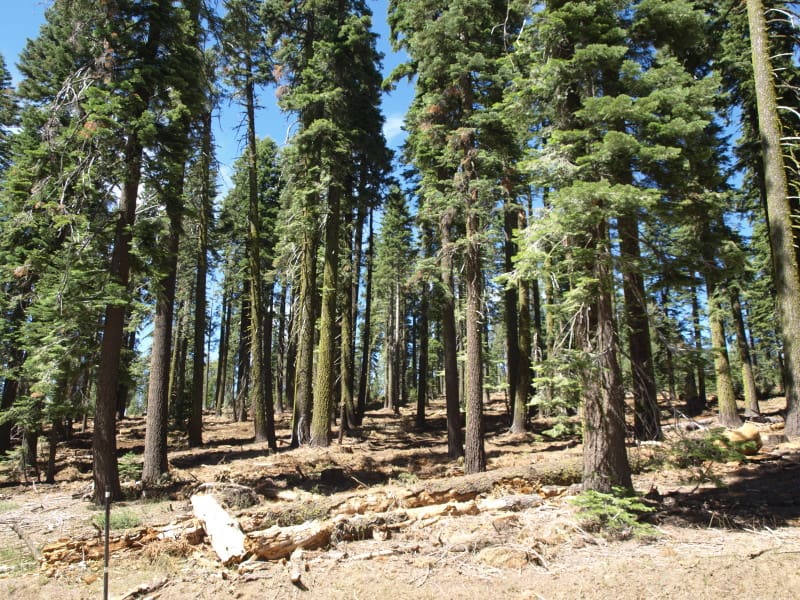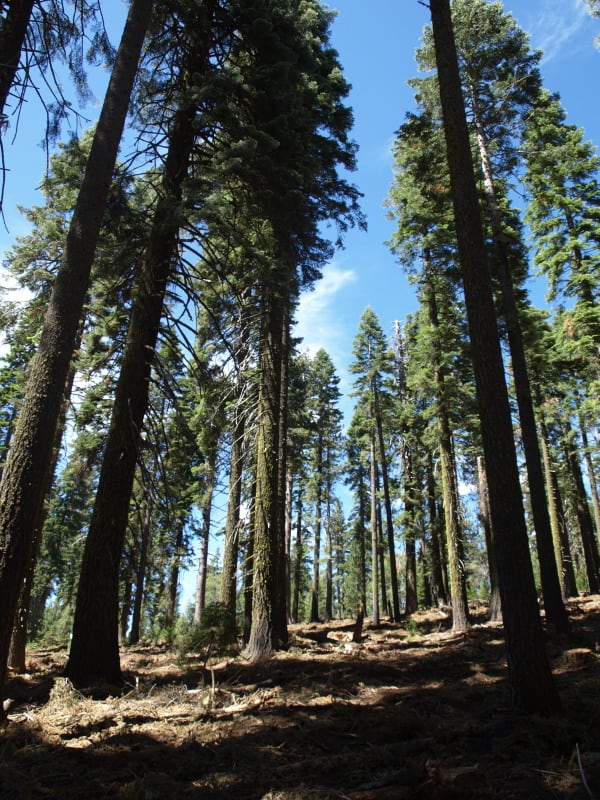This is an example of what our thinning projects look like, when completed. As you can see, the stand is still well-stocked, and ladder fuels have been removed. You can also see that the stand will be resilient and that all the logging slash has been removed, as well. In looking closer, I’m not seeing any damaged trees, as well. Additionally, no large trees ( over 30″ dbh ) were cut, unless they could fall and hit the adjacent highway.
This logging was done during this season, and work is continuing in other units. The project is quite visual, being all along a major Sierra Nevada highway. We call this style of project “thinning from below”. Any thoughts?


Great pictures, Larry, it’s almost like being there.. ponderosa pine and is that white fir?
At this elevation of nearly 6000 feet, most of the pines are Jeffreys and sugars. The white firs dominate these stands, and they have tried to clear out the firs from the pines and oaks, where they occur.
What is the significance of a 30″ dbh tree? Is that a regulatory/forest plan requirement? If not, can someone point me in the direction of some science that shows that 30″ dbh is the magic number for qualification as a “big tree”?
Furthermore, what is the next sheduled entry into that stand? Regeneration harvest?
What is the “normal” disturbance regime in that forest type? Mixed severity fire? If so, why was not more of the stand opened up for regeneration with early successional species?
If all you’ve done is thin the the white firs or other shade tolerant climax species from these stands ostensibly as a “fuel reduction” then basically you are perpetuating another round of shade tolerant undergrowth that will require another ground disturbing entry in the future to maintain the fuel reduction benefits. (I’m not familiar with that forest type so tell me if I’m all wet here).
I’m not a fan of thinning from below in mixed severity regimes where regeneration harvest is warranted. It’s easier to “sell” to the publics and “looks” better but looks are an exceedingly short sighted and selfish forest management purpose from an ecology perspective.
If regen harvest is warranted and it’s highly visual, perhaps there is an opportunity for an interpretive site explaining some basic forest ecology perspectives to the layperson.
Again, if I’m off-base with the disturbance regime, then just chalk the above up to a “rant” and we’ll move on.
By the way Larry….it “looks good”.
With the current rules laws and policies, this is what we are left with. Of course, Clinton pushed for a 20″ dbh limit, with some limits as low as 12″ dbh. Chad Hanson wants ZERO merchantable trees cut, as he will continue to litigate all timber sales here. This is what we’re stuck with.
You are correct about perpetuating the fir domination though. We try to enhance the pines and oaks but, if those trees are sparse, then we are merely thinning out the smaller firs and lots of incense cedars. We do have the power to install or enhance “gaps” and “clumps”, for structural diversity. A gap could be an area of low site, or an anosus patch. Clumps are groups of at least 6-10 large trees in an area to be untouched.
You say “What is the “normal” disturbance regime in that forest type? Mixed severity fire? If so, why was not more of the stand opened up for regeneration with early successional species?”
I suggest … If this is a mixed severity fire regime why not let mixed severity fire do the work? Why add human disturbance (artificial regen) on top of natural disturbance to cause uncharacteristic cumulative disturbance?
Regen logging does not mimic natural disturbance because it exports the forest structure whereas fire’s retain complex structure and use that structure as a template from which to initiate and develop complexity and diversity.
A major wildfire burned to within a mile or so of this site. The fire killed both smaller trees and old growth. Bark beetles also killed many survivors of the wildfire. Pretending that such wildfires are “natural and beneficial” and embracing the destruction seen in the Power Fire photos I posted is simply ignorance of the results. I’d rather retain more old growth than to hope that a wildfire won’t kill most of it. No large trees die in our thinning projects, and those trees health is enhanced by the thinning. Plus, we cannot do “real” regeneration logging when we can’t take trees bigger than 30″ dbh.
Live in a house made of wood? Use TP?
Exporting some forest structure to a mill has other benefits too.
Regen logging can not mimic natural disturbance…correct. There are design criteria, protocols and reguations (snag, green tree and coarse woody debris retention requirements) that lessen the impact and provide for all the good stuff you mentioned above.
Allowing natural processes to shape the forests is appropriate in wilderness and remote roadless areas, not right next to a major highway. The logistical considerations alone (from a fire mgmt perspective) make that a really bad idea.
The 30″ diameter limit is a legacy of the original California Spotted Owl guidelines for new nesting habitats. I believe it is also a part of the Sierra Nevada Framework. While we would love to be able to cut larger, more decadent white firs, in favor of restoring healthy and resilient pines, it will take major changes to eliminate those diameter limits. Instead, smaller, younger pines get cut, while larger, rotten firs are untouchable.
Diameter limits are a good way to:
1) protect large trees (and future large snags) that are ecologically valuable and rare relative to historic norms;
2) build and maintain public trust while the agencies continue to give us many reasons to mistrust;
3) protect existing stores of carbon that will remain in storage for some time even after the tree dies;
4) retain structure that will be valuable in the future when a fire or other disturbance occurs;
5) retain fire resilient trees and canopy cover that helps maintain cool/moist conditions, and slow the growth of ladder fuels;
6) maintain and restore spatial variability within thinned stands;
7) respect members of the community of life that have shown the ability to persist in situ for long periods;
Tree,
Can you please steer me towards some science showing that application of an abitrary diameter limit achieves the above better than could be designed by a team of professional interdisciplinary specialists.
What is better to keep? A 31″ dbh white fir, with a huge rotting mistletoe canker at 10 feet, or a 29″ dbh sugar pine, growing 4 feet from the fir? In my case, the decision has already been made. The pine must go, under our spacing guidelines. I fully realize the risk of abusing such discretion and trust. For any new program of restoration, it must be accompanied with total transparency. As it is now, there is little oversight regarding the current diameter limits.
Good photos! So historically, what was the groundcover beneath Jeffrey and sugar pines? Looks like mostly needle thatch now, but assume that was from the denser stand conditions. Assume these are fairly poor, dry soils at this elevation or are they slightly more mesic? What’s the ecological system, California Montane Jeffrey Pine-(Ponderosa Pine) Woodland, Mediterranean California Dry-Mesic Mixed Conifer Forest and Woodland, or Mediterranean California Mesic Mixed Conifer Forest and Woodland?
I would think it is that first one you mentioned. I’m sure that the pines were high-graded, decades ago, and the firs took over. Many of the ridgetops in this area have “lava caps”, resulting in poor sites. Other ridgetops favor the yellow pines, and sugars grow wherever they can. If the soils can support such fir densities, there should be a chance that pines can be re-established, when the firs die or are burned off. Jeffrey pines with kinnickkinnick below makes a very resilient ecosystem. Whitethorn, deerbrush and manzanita often will dominate, if given enough light.
How old is stand. How many MBF removed per acre(+-). Does look like nice scenic corridor job.
I’m sure that some of the fir leave trees are up to 200 years old. Any large pines left are surely over 300 years old. I’ve seen 60″+ dbh pines in the area. I don’t know how much volume was removed but, there are sizable slash piles on every landing. I wish we could use that biomass, rather than piling and burning it.